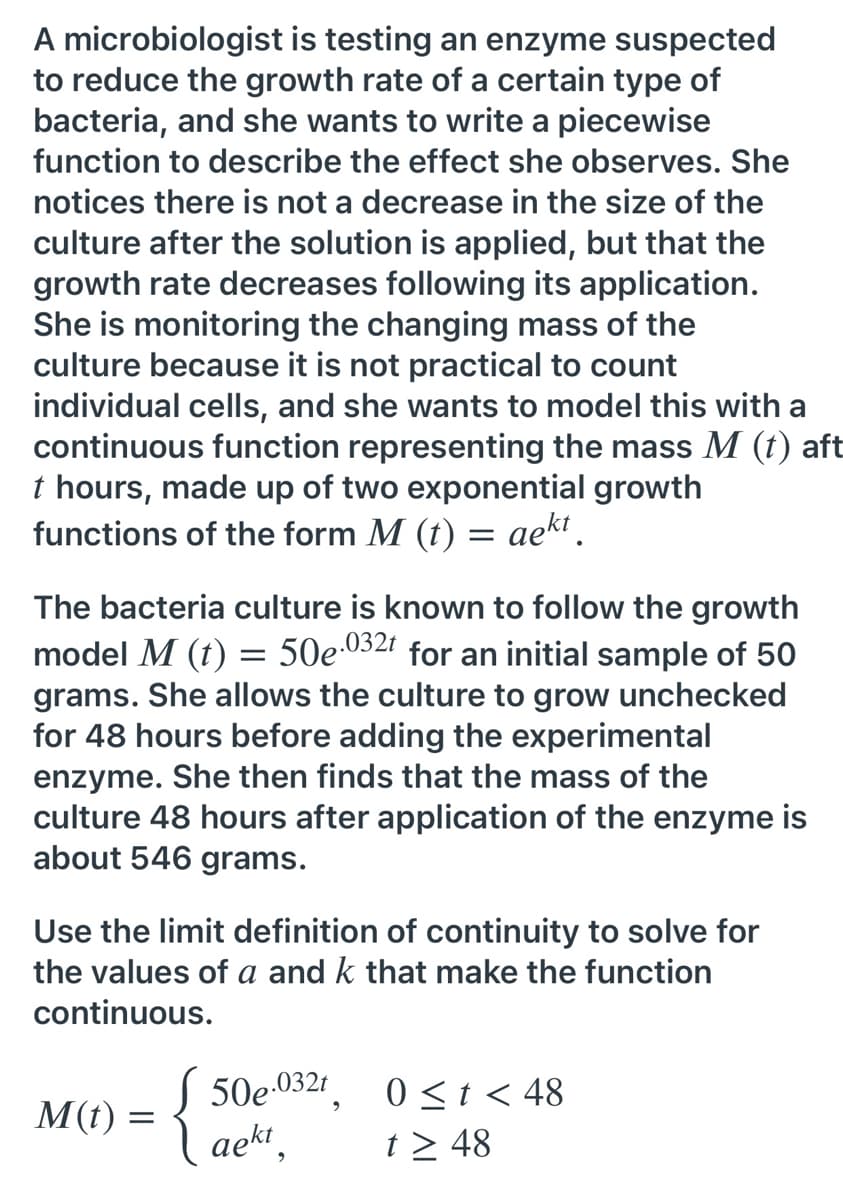A microbiologist is testing an enzyme suspected to reduce the growth rate of a certain type of bacteria, and she wants to write a piecewise function to describe the effect she observes. She notices there is not a decrease in the size of the culture after the solution is applied, but that the growth rate decreases following its application. She is monitoring the changing mass of the culture because it is not practical to count individual cells, and she wants to model this with a continuous function representing the mass M (t) aft t hours, made up of two exponential growth functions of the form M (t) = aekt. The bacteria culture is known to follow the growth model M (t) = 50e-032r for an initial sample of 50 grams. She allows the culture to grow unchecked for 48 hours before adding the experimental enzyme. She then finds that the mass of the culture 48 hours after application of the enzyme is about 546 grams. Use the limit definition of continuity to solve for the values of a and k that make the function continuous. S 50e.0321, 0 48
A microbiologist is testing an enzyme suspected to reduce the growth rate of a certain type of bacteria, and she wants to write a piecewise function to describe the effect she observes. She notices there is not a decrease in the size of the culture after the solution is applied, but that the growth rate decreases following its application. She is monitoring the changing mass of the culture because it is not practical to count individual cells, and she wants to model this with a continuous function representing the mass M (t) aft t hours, made up of two exponential growth functions of the form M (t) = aekt. The bacteria culture is known to follow the growth model M (t) = 50e-032r for an initial sample of 50 grams. She allows the culture to grow unchecked for 48 hours before adding the experimental enzyme. She then finds that the mass of the culture 48 hours after application of the enzyme is about 546 grams. Use the limit definition of continuity to solve for the values of a and k that make the function continuous. S 50e.0321, 0 48
Algebra & Trigonometry with Analytic Geometry
13th Edition
ISBN:9781133382119
Author:Swokowski
Publisher:Swokowski
Chapter4: Polynomial And Rational Functions
Section: Chapter Questions
Problem 5T
Related questions
Question

Transcribed Image Text:A microbiologist is testing an enzyme suspected
to reduce the growth rate of a certain type of
bacteria, and she wants to write a piecewise
function to describe the effect she observes. She
notices there is not a decrease in the size of the
culture after the solution is applied, but that the
growth rate decreases following its application.
She is monitoring the changing mass of the
culture because it is not practical to count
individual cells, and she wants to model this with a
continuous function representing the mass M (t) aft
t hours, made up of two exponential growth
functions of the form M (t) = aek.
The bacteria culture is known to follow the growth
model M (t) = 50e.032r for an initial sample of 50
grams. She allows the culture to grow unchecked
for 48 hours before adding the experimental
enzyme. She then finds that the mass of the
culture 48 hours after application of the enzyme is
about 546 grams.
Use the limit definition of continuity to solve for
the values of a and k that make the function
continuous.
.032t
0 <t < 48
t > 48
M(t) =
aekt,
Expert Solution
This question has been solved!
Explore an expertly crafted, step-by-step solution for a thorough understanding of key concepts.
This is a popular solution!
Trending now
This is a popular solution!
Step by step
Solved in 2 steps with 2 images

Recommended textbooks for you

Algebra & Trigonometry with Analytic Geometry
Algebra
ISBN:
9781133382119
Author:
Swokowski
Publisher:
Cengage

Algebra & Trigonometry with Analytic Geometry
Algebra
ISBN:
9781133382119
Author:
Swokowski
Publisher:
Cengage